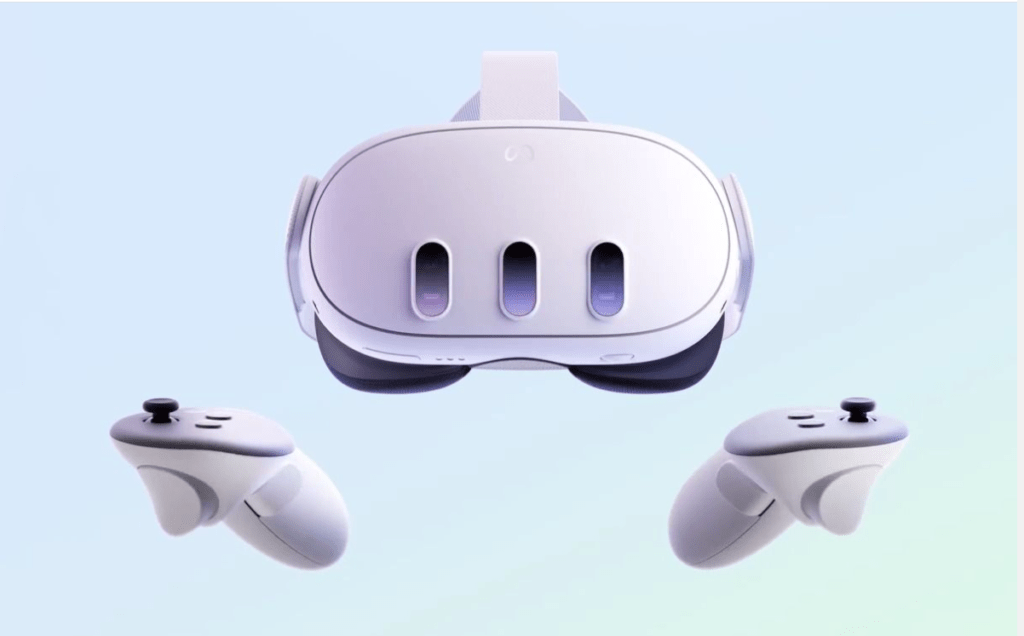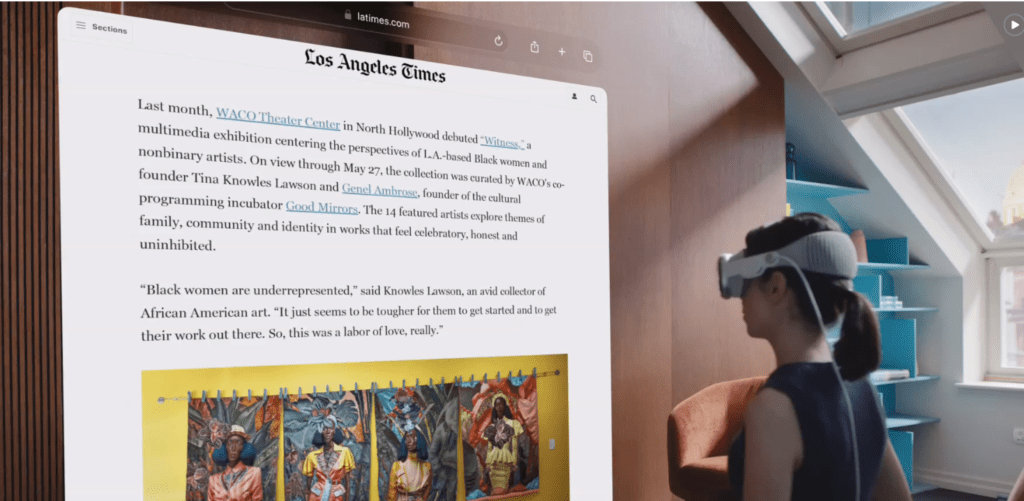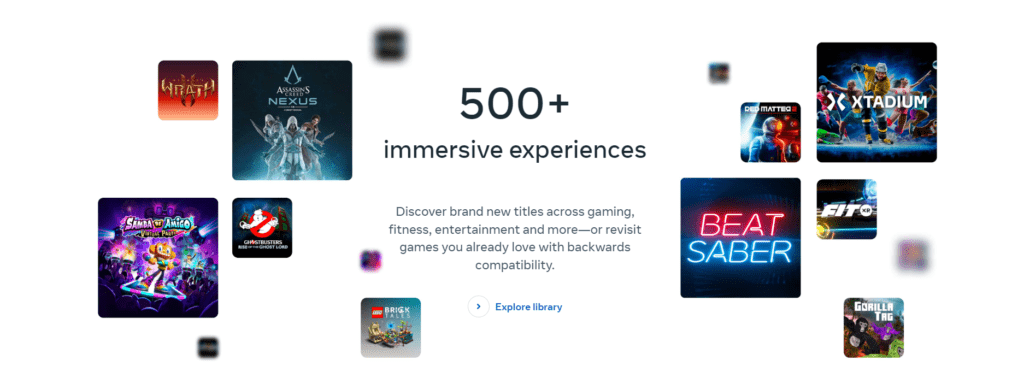Introduction
Virtual reality (VR) and augmented reality (AR) headsets are expected to be an exciting consumer electronics category in 2023 and beyond. Major players like Meta and Apple are investing heavily in developing advanced and mainstream-friendly devices to usher these immersive technologies into the mass market.
The Meta Quest 3 is anticipated to launch in late 2023 as the successor to the popular Quest 2. With each new iteration, Meta has focused on improving areas like comfort, visual fidelity, and expanding the functionality to bridge VR and AR applications.
Apple has been long-rumored to be working on a high-end consumer VR/AR headset currently known as Apple Vision pro. As Apple’s first device in this market, it is expected to leverage the company’s strengths in hardware and software integration to offer a polished consumer experience.
This article will compare the known and expected specifications of the Meta Quest 3 vs Apple Vision Pro. Given one is confirmed and the other is unannounced, this analysis requires some informed speculation. We’ll look at the critical factors like displays, lenses, tracking capabilities, controls, and software that will determine these products’ overall capabilities and use cases.
Display and Optics
A VR headset lives and dies by the quality of its displays and lenses. These determine critical factors like resolution, field of view, refresh rate and the all-important immersion experience.
Meta Quest 3

The Meta Quest 2 featured fast-switch LCDs with 1832×1920 per eye resolution and 90Hz refresh rate.
Reliable leaks point to the Quest 3 significantly upgrading visuals with mini-LED displays at 2448×2448 pixels per eye and supporting 120Hz variable refresh rate (VRR). Mini-LED backlighting brings higher contrast, deeper blacks, and reduced halo artifacts.
The wider color gamut and much denser pixels per inch should minimize visible screen door effect. Support for foveated rendering may further enhance perceived clarity in the wearer’s focal area.
Field of view is expected to increase marginally from 90 degrees horizontal in the Quest 2 to 95 or 100 degrees. This expands the sense of immersion in the virtual world.
Apple Vision

Credible reports suggest Apple Vision will adopt cutting-edge micro-OLED displays with resolution up to 4000 pixels per inch per eye. For reference, the iPhone 14 Pro has ~460 PPI.
Micro-OLED enables far smaller pixel sizes, resulting in a perceived infinite resolution with no visible pixels. Color accuracy, brightness, and contrast should be best-in-class.
The headset is rumored to have an extremely wide field-of-view between 140 to 220 degrees diagonal. This would significantly exceed any mainstream or even high-end VR device available.
Ultra-dense pixel count combined with an expansive FOV contributes to a sense of “retinal resolution” where virtual objects become indistinguishable from real objects.
Rumors point to Apple using specialized pancake lenses to achieve compact form factor while delivering this class-leading FOV. These lenses warp images to focus on certain areas like straight-ahead vision while reducing fidelity at the peripheral zones. Advanced eye-tracking and foveated rendering maximize perceived clarity.
For AR functionality, the Vision may employ birdbath optics using a secondary lens with a reflective mirror. This would enable stereoscopic passthrough AR merging virtual graphics atop real-world views.
Comparison
Based on leaks, Apple Vision delivers a decisive advantage in visual fidelity and immersion. The expected ~4K per eye micro-OLED displays far exceed Quest 3’s mini-LED specs. An up to 2.5x greater field-of-view paired with advanced optics contributes to a much more enveloping experience.
Apple is essentially leapfrogging to realize many of the long-term promises of VR/AR headsets in a single product. Of course, this cutting-edge tech may come at a steep price unlikely to be mainstream. Meta Quest 3 makes more incremental upgrades, but keeps price accessible to the masses.
Tracking and Spatial Mapping
Robust spatial mapping and tracking enables users’ positions and movements to be captured accurately in VR. This allows interaction with virtual objects and free movement through the environment.
Meta Quest 3
The Quest 2 and Quest Pro pioneered Meta’s inside-out “Insight” tracking leveraging onboard cameras and sensors. No external beacons or modules required.
Quest 3 is rumored to increase the number of cameras to 10, up from 5 on prior models. Additional sensors around the band may also assist in tracking arm movements and proxies for legs/feet.
Enhanced computer vision algorithms for Insight should expand controller-less hand tracking functionality. Room-scale guardian boundaries for safe VR spaces also get an upgrade.
Apple Vision
Apple acquired VR sensor startup NextVR in 2020, suggesting advanced stereo infrared cameras for tracking vision and motions. Lidar integration seems probable given its use in recent iPads and iPhones.
Lidar can map surroundings in 3D, enabling accurate room-meshing and occlusion of virtual objects by real surfaces. Eye-tracking helps rendering and foveated focus too.
Ultra-wideband (UWB) radio may play a role in tracking the precise position and orientation of multiple devices like headset and wrist controllers.
Comparison of Meta Quest 3 vs Apple Vision Pro
Both headsets take an inside-out, sensor-first approach to deliver compelling movement freedom untethered from a PC and without exterior equipment.
Apple Vision looks to have an edge from adoption of emerging technologies like lidar and UWB. Precise real-time room geometry with occlusion makes mixed reality more believable. Eye-tracking optimizes perceived quality.
But Meta’s Insight platform is mature and battle-tested for room-scale VR across millions of Quest 2 users. The Quest 3 promises iterative refinements to excellent inside-out capabilities already established.
So while Apple may claim technical advantages, Meta’s solution likely delivers rock-solid tracking suitable for nearly all VR gaming and productivity applications.
Controllers

Natural input devices that act as hands in the virtual world are crucial for immersive user experiences. Controller ergonomics, intuitive buttons/sticks, haptic feedback, and versatile tracking all play key roles.
Meta Quest 3
Meta changed the game with the excellent Touch controllers bundled with every Quest headset. Their ergonomic fit in each hand and capacitive triggers enable precise interactivity, pressure sensing, and realistic haptic sensations.
The Touch controllers have outside-in infrared tracking on Quest 2 for low-latency response. But the Quest Pro adopted inside-out tracking using the headset cameras.
Quest 3 is expected to follow suit with inside-out tracked controllers. They should be similar to Touch but with refined ergonomics and additional touches like finger position sensing. Haptic feedback gets an upgrade with improved vibration motors.
Battery life may get a boost while onboard processing allows more functionality independent of the headset like the wrist menus on Quest Pro.
Apple Vision

Each Vision headset will reportedly ship with a matching pair of premium wrist controllers. These may take design cues from Apple Watch with curved glass touch displays around the wrist band.
Haptic feedback recreates sensations of touching virtual objects. Ultra-precise tracking keeps latency imperceptible as you interact within simulations.
A clever expanding/retracting hand strap mechanism lets users easily take controllers on and off. Onboard battery is good for multiple days of typical usage for convenience.
The main controller interface relies on powerful gesture recognition via capacitive multi-touch surfaces across the band. Visual clues like rendering virtual hands give feedback as you touch virtual objects.
A secondary dial/scroll controller mounts to the bottom for precise input in creation apps. Physical clicks actuate via isometric haptics without actual buttons.
Comparison

Both platforms invest heavily in purpose-built controllers central to VR and AR experiences. Meta’s Touch input pioneered inside-out tracking, ergonomic feel in-hand and capacitive sensing for physics interactions in virtual worlds.
Apple Vision looks to realize incredibly advanced wrist controllers seemingly years ahead with features like curved glass touch displays and multi-day battery. Ultra-wideband tracking promises nearly imperceptible latency for using your virtual hands.
While exciting on paper, it remains to be proven whether Apple can execute this ambitious vision into a comfortable, durable accessory ready for consumers. History favors Meta having refined its Touch controllers across two generations to meet demands of highly active VR usage.
Apple’s wrist controller leaks sound phenomenal. But Meta’s iterative improvements on proven Touch controllers seem a safer bet for all-day VR immersion.
Software Platform
The headset hardware provides capability foundations, while software ecosystems unlock the real functionality. App stores, APIs, development tools and runtimes determine what you can actually do in these virtual worlds.
Meta Quest 3

As a third-generation device, the Quest 3 benefits from Meta’s well-established Android-based VR ecosystem tailored for accessibility and scale.
The platform boasts hundreds of quality apps and games on its store curated for standalone VR without need for wires or PC connectivity. Popular experiences range from virtual workspaces and social VR like Horizon Worlds to award-winning games such as Resident Evil 4 and Beat Saber.
Open development tools like Unity and Unreal engines combined with Meta’s APIs and distribution infrastructure have proven successful at nurturing innovation across individuals, startups and enterprises.
Release of the Quest 2’s successor should catalyze a new wave of apps and experiences capturing capabilities like upgraded visuals, new input methods and room-scale tracking advances.
Backward compatibility with Quest 2 apps provides some assurance against software drought risks common with new platforms.
Apple Vision
As an augmented reality headset too, Apple Vision requires brand new software frameworks.
Expect deep integration with existing Apple ecosystems — App Store distribution, Swift and Metal development tools, iOS/iPad OS/Mac OS/Watch OS APIs for connectivity, SwiftUI UI frameworks and more.
New domain-specific capabilities will handle areas like room meshing, occlusion, physics interactions, eye and face tracking along with building out stereo UI conventions.
Tim Cook suggested “the kinds of things that we would all like to have from a VR experience” are still lacking. This implies Apple is developing novel applications leveraging its strengths in hardware-software integration versus pure VR gaming focus.
Potential “killer app” targets seem concentrated on creativity tools, communication solutions for hybrid remote work and hyper-immersive entertainment/sports consumption.
Comparison
Meta’s established Quest platform lowers risks for consumers and developers thanks to an extensive app ecosystem and proven tooling. Apple promises tighter integration with its ubiquitous iPhone/Mac ecosystems while pioneering new frameworks custom-built for next-generation immersive computing.
For actual VR applications today, Meta’s substantive head start seems likely to provide the richest libraries and interaction paradigms as developers port existing apps or build new ones against Quest 3 capabilities.
But Apple promises to extend or reimagine computing for spatial and AR-centric workflows Refreshing hardware may better serve these emerging use cases. However execution risks run high launching an entirely new platform.
The Quest 3 appears stronger for VR gaming and entertainment thanks to incumbency. But the Vision headset may excel in AR along with creative and productivity uses should Apple successfully cultivate this new ecosystem.
Price and Release Date
Of course, a key factor in adoption will be retail cost and availability timelines to consumers.
Meta Quest 3 is expected to be priced between $300 to $500 positioning it both as the high-end Quest model and Meta’s most affordable 2023 offering against the business-focused Quest Pro.
Announcement is possible by mid-2023 although supply chain issues may impact exact release timing. There is outside possibility that a higher-tier Quest model may also emerge later.
Rumored manufacturing price for Apple’s VR headset exceeds $2000 per unit given the exotic materials and components required. Retail pricing speculation ranges from $1000 on the very low end up to $3000+ for a finished Apple quality package including the customized controllers and requisite software platforms.
Launch timing remains hazy but leaks suggest pre-announcement in early 2023 with limited developer distribution and subsequent public release before year’s end after app ecosystem has matured.
This should establish the product as an ultra-premium device compared to all existing consumer VR hardware. But a subsequent model perhaps 2 years out might target more mainstream pricing levels.
Conclusion
Meta Quest 3 and Apple Vision represent exciting milestones on the road to widespread adoption of immersive technologies leveraging VR and AR.
The Quest 3 looks to make significant but expected refinements on proven standalone VR capabilities for gaming and entertainment. Apple’s debut headset seems poised to break new ground in areas like mixed reality and design applications should its riskier technical foundations pay off with polished consumer implementation.
While specs and features weigh toward Apple on paper, Meta’s incumbency advantages shouldn’t be underestimated given the complexity of delivering complete headsets along with robust supporting software platforms.
For most consumers in the market for quality VR today, Meta Quest 3 offers the safer bet for affordability and richer software ecosystems. But Apple could outpace Meta’s wildest expectations should its infinity screen and expansion into AR spawn transformational new use cases.
Exciting times are ahead with two tech titans pushing boundaries of commercial immersive hardware available to consumers. Within a few years, these leading-edge headsets should give way to even more compact, powerful and accessible designs—likely when the real battle for the next great computing platform truly takes off.




